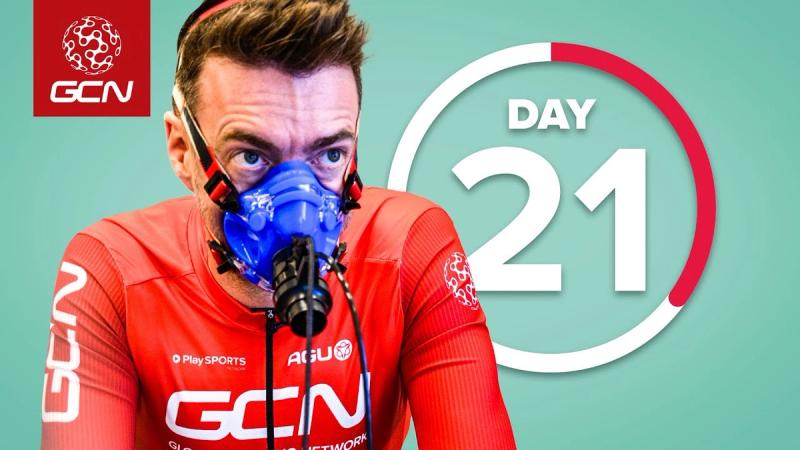Fitness
Dan Lloyd’s journey back to fitness and health: The importance of VO2 max

I’ve done a lot of VO2 max tests in my adult life, and they’ve all had one thing in common: I’ve hated every single one of them.
Except the most recent one.
To accurately test your VO2 max, you need to push yourself to your physical limits. They’re painful, and I think best described as ‘an ordeal’. The icing on the cake is the tightly fitting mask on your face, whilst the cake itself is the excruciating pain in your legs and lungs as you near exhaustion.
There are some things I miss about being a pro cyclist, but there are a lot that I don’t. Training in the rain, filling in my anti-doping ‘Whereabouts’ every single day of the year, living out of a suitcase and crashing all immediately spring to mind. But VO2 max tests are very near the top.
Read more: What are power and heart rate zones and what do they mean for cyclists?
So why didn’t I hate the latest one? Because I’ve recently learnt that VO2 max is not only a fitness marker for elite endurance athletes to be interested in – we should ALL know what ours is, and keep it as high as we can, if we want to live the longest, healthiest lives possible. That is what episode 2 of my journey back to health and fitness is all about: why we should all be concerned with our VO2 max. You can find that video embedded within this article.
If you’re still sceptical (I would have been had I read this a year ago), please allow me to quote Peter Attia, one of the most respected longevity experts in the world. I’ve listened to a lot of his podcasts, and I’m most of the way through his book, Outlive: The Science & Art of Longevity. This is what he has to say on the subject of VO2 max:
“It is THE greatest predictor of lifespan. More strongly associated with reduced mortality risk than ANY other metric we know of.”
That sentence alone, when I heard it on a podcast, made me sit up, pay attention, and change my perspective. Of ALL the metrics we have to predict how long we are going to live, VO2 max is the best. That’s powerful. Attia goes on to say:
“Whether you smoke or don’t smoke, whether you have diabetes or don’t have diabetes, whether you have end stage kidney disease or don’t, whether you have heart disease or not, hypertension or not, all of those things play an important role in predicting the length of your life, but not as much as having a very high VO2 max. VO2 max rises above every other biomarker we have to predict the end of life.”
That’s not to say that the only thing we should be doing from here on in is trying to raise our VO2 max, it’s simply to highlight its importance. I’ll be covering the other things we should be paying attention to over the course of this series.
Read more: Dan Lloyd: Why I’ve decided to change my lifestyle
Those of you who watched episode 1 may remember that my VO2 max was measured at 52 when I started this journey a few weeks ago. As many pointed out in the comments, that’s not a number that is concerning. In fact it just about gets me into the ‘elite’ category for my age and gender. However, it’s quite the slump (>30%) since my last test in 2010, in which I recorded a VO2 max of 74.6.
In knowing what I know now, I obviously want to curb that decline, or hopefully even push it back. I’ve ‘gotten away’ with my lifestyle of the last 12 years because I started from such a high point, but I can’t afford to continue in that downward trajectory.
Unfortunately, though, it will decline… eventually. If we maintain the same levels of exercise from now until the end of our lives, our VO2 max will decline by 8-10% per decade, or around 1% per year. So, the higher we can get it now, the higher it’ll be in later life. The higher it is in later life, the more likely it is we’ll still be able to walk up stairs, ride bikes, pick up grandchildren or walk to the shops. I’ve found that thought particularly motivating – I may no longer have the desire to compete, or even take a Strava segment (never say never), but I do want to remain independent in my mobility for as long as I can. That process starts now.
The changes so far
What does that process look like at the moment? Well, I have made several changes to my lifestyle since episode one was released.
Firstly, I managed to stop the nicotine replacements almost four weeks ago. I’d been on them for four years. I did it ‘cold turkey’ and… So far, so good.
Read more: How bad is alcohol for cycling performance?
Secondly, I have reduced my alcohol consumption. Previously, I’d drink four to five nights a week, but I’m now only drinking on Fridays and Saturdays. That’s probably a reduction of around 30 units a week for me, given that I tend to drink strong beers, and quite a few of them.
Thirdly, I’ve been moving! Since episode one, I’ve done some sort of exercise every single day. Nothing excessive, but something. Some cycling, some running, some rucking (walking and hiking with a weighted backpack), and I’ve even joined a gym. I haven’t been doing anything too specific just yet, I just wanted to get into a routine of exercise again and make it a habit.
I’ve already seen some significant changes. I’ve recorded my highest HRV and my lowest resting heart rate since I started using a Whoop two and a half years ago. In the graphs below, you can see the effects that alcohol has on both those metrics.
On another note, I wanted to finish by saying that I was really blown away by the response to that first episode. I had come to a point in my life where I wanted to make a few changes, so I thought I’d document them, but I had no idea just how many of you were in such a similar space. If you’ve started your own journey since, I sincerely hope it’s going well for you. Let me know in the comments how you’ve been getting on.
I shall see you all soon for episode 3. In the meantime, it’s time for me to see if I can stay on the straight and narrow whilst covering the Giro d’Italia. Wish me luck!
You can keep up to date with Dan’s progress here on the GCN website and over on the GCN YouTube channel. Let us know in the comments below if Dan’s inspired you to make some lifestyle adjustments. We’d love to hear your stories too.









